Eliza Knight's Blog, page 64
November 30, 2011
Guest Author Sharon Lathan on Paris in the Early 1800's
 Welcome guest author, Sharon Lathan to History Undressed! I spent many a summer in my youth in France and I LOVE Paris AND this time period, so I'm especially excited for you all to read Ms. Lathan's post today! Please leave a comment for your chance to win a copy of Miss Darcy Falls in Love. (1 winner, US/Canada only).
Welcome guest author, Sharon Lathan to History Undressed! I spent many a summer in my youth in France and I LOVE Paris AND this time period, so I'm especially excited for you all to read Ms. Lathan's post today! Please leave a comment for your chance to win a copy of Miss Darcy Falls in Love. (1 winner, US/Canada only).Paris in the Early 1800sby Sharon Lathan
Whether you have been to Paris or not there are certain imagesthat instantly flash in your mind when the ancient city is mentioned. Soingrained are these visions of what Paris IS that perhaps you might be surprisedto learn that many of the iconic Paris sights either did not exist 200 yearsago or were vastly different.
My latest novel - Miss Darcy Falls in Love - is set in1820. At that time Napoleon Bonaparte was in exile on the island of SaintHelena and the Bourbon Restoration was underway with Louis XVIII on the throne.There was a measure of stability, but the long decades of war and revolutioncoupled with the major political upheavals ongoing meant that France was farfrom peaceful. Paris, as the capitol, showed the greatest evidence of thenumerous trials. Scars were visible at every corner despite Napoleon and Louis'attempts to reconstruct, and disorganization was constant. It would be manydecades more before Paris truly became the glittering city it now is.
Nevertheless, in 1820 life for the Parisians was near perfectioncompared to the previous thirty-some years. Opera, theatre, arts, and socialactivities abounded. Yet, as I said, many of those places now top tourist trapswere not available to Miss Darcy and her friends.
Eiffel Tower: Today itis the tallest building in Paris and one of the most visited monuments inEurope, but it was not built until 1889. The large flat open park called the Champ de Mars, where the Tower stands,had served as a site for executions during the Revolution and militarytraining, but by 1820 was a popular park for festivals and other celebratoryevents.
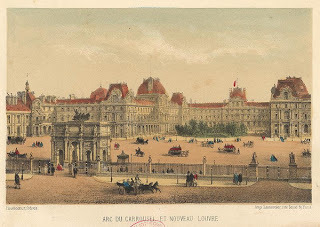 Musée du Louvre:Originally a palace and fortress, the Louvre was transformed into a publicmuseum during the French Revolution, the royal collections viewable for thefirst time. Located close to the TuileriesPalace, the Louvre Palace was structurally renovated several times duringthe 17th and 18th centuries, it's general splendor as we now see it. However,in the early decades of the 19th century it was far smaller than it now is andheld considerably less works of art. All through the century vast wings wouldbe added on to house the flood of art arriving from all over the world until iteventually became a massive complex with the palace only one portion of thewhole. So huge is the present day Louvre that it cannot be captured in onephoto. When Georgiana and Sebastian tour the Louvre it is still a seat of royalpower with the Tuileries standing, already supremely impressive as a museum,and undergoing constant construction.
Musée du Louvre:Originally a palace and fortress, the Louvre was transformed into a publicmuseum during the French Revolution, the royal collections viewable for thefirst time. Located close to the TuileriesPalace, the Louvre Palace was structurally renovated several times duringthe 17th and 18th centuries, it's general splendor as we now see it. However,in the early decades of the 19th century it was far smaller than it now is andheld considerably less works of art. All through the century vast wings wouldbe added on to house the flood of art arriving from all over the world until iteventually became a massive complex with the palace only one portion of thewhole. So huge is the present day Louvre that it cannot be captured in onephoto. When Georgiana and Sebastian tour the Louvre it is still a seat of royalpower with the Tuileries standing, already supremely impressive as a museum,and undergoing constant construction.Arc de Triomphe: Themonument to honor those who fought and died for France in the Revolutionary andNapoleonic Wars was conceived in 1806. The foundations were laid in 1810 butconstruction halted during the Restoration, the final structure not completeduntil 1836. Therefore, my characters would not have seen this marvel. Insteadthey stroll through the Tuileries Gardens and pause at the smaller Arc de Triomphe du Carrousel. Built in1808 by commission of Napoleon to commemorate his military victories, thelesser Arc was nevertheless an impressive sculpture and integral part of the axe historique (grand historic axis) ofParis. Pictured here you can see the Arc with the Louvre behind as it wouldhave looked in 1820.
 Notre Dame Cathedral:Completed in 1250, Notre Dame is the "World Ambassador of Gothic Cathedrals."For seven hundred years it has stood on the site of ancient sacred ground,revered and generally well cared for except during the years of the Revolution.Churches in France were universally rededicated to the "cult of Reason" andNotre Dame suffered severe defacement, destruction, and desecration. Until themid-19th century the cathedral was ignored as a house of worship, used insteadas a storage facility and place for public gatherings. It is unlikely that MissDarcy, or anyone visiting Paris in 1820, would have taken the time to visit theruined Notre Dame.
Notre Dame Cathedral:Completed in 1250, Notre Dame is the "World Ambassador of Gothic Cathedrals."For seven hundred years it has stood on the site of ancient sacred ground,revered and generally well cared for except during the years of the Revolution.Churches in France were universally rededicated to the "cult of Reason" andNotre Dame suffered severe defacement, destruction, and desecration. Until themid-19th century the cathedral was ignored as a house of worship, used insteadas a storage facility and place for public gatherings. It is unlikely that MissDarcy, or anyone visiting Paris in 1820, would have taken the time to visit theruined Notre Dame. Other famous attractions not in Paris at the time of my novelinclude Cleopatra's Needle (1833), Elephant of the Bastille (the fountainand model elephant were present by 1814, but the elephant not completed until1833 and has since been removed), the Sacré-Coeur(1873), the Moulin Rouge (1889), orthe Opéra de Paris Garnier.
Do not feel sorry for my characters though! They did visit theLouvre and walked the Tuileries Gardens. They also toured the Panthéon, rode down the Champs-Ėlysées, saw the exotic animalsand plants in the Jardin des Planteszoo and botanical gardens, and socialized along the pathways of the Place de la Concorde. Did I mention theopera houses, salons, ballrooms, and palatial chateaûs? Paris of 1820 may havebeen in moderate chaos and a paler version of what it now is, but the City ofLight was phenomenal nonetheless. And the perfect place to immerse in music andfall in love.
Synopsis of Miss DarcyFalls in Love--
[image error] Noble young ladies were expected to play an instrument, butGeorgiana Darcy is an accomplished musician who hungers to pursue her talents. Sheembarks upon a tour of Europe, ending in Paris where two very different menwill ignite her heart in entirely different ways and begin a bitter rivalry towin her. But only one holds the key to her happiness.
Set in post-Napoleonic Empire France, Miss Darcy Falls in Love isa riveting love story that enters a world of passion where gentlemen knowexactly how to please and a young woman learns to direct her destiny andunderstand her heart.
Sharon's Bio--
Sharon Lathan is the best-selling author of The Darcy Saga sequelseries to Jane Austen's Pride &Prejudice. Her previously published novels are: Mr. and Mrs. Fitzwilliam Darcy: Two Shall Become One, Loving Mr. Darcy,My Dearest Mr. Darcy, In the Arms of Mr. Darcy, A Darcy Christmas, and The Trouble With Mr. Darcy. Miss Darcy Fallsin Love is Georgiana's tale of love and adventure while in France. Completewith a happy ending. In addition to her writing, Sharon works as a RegisteredNurse in a Neonatal ICU. She resides with her family in Hanford, California inthe sunny San Joaquin Valley. Visit Sharon on her website: www.sharonlathan.netand on Austen Authors, her group blog with 20 novelist of Austen literature: www.austenauthors.com
Published on November 30, 2011 04:03
November 25, 2011
Regency Weddings @ Romancing the Past Today
 Visit me today at Romancing the Past for a post on Regency Weddings...
Visit me today at Romancing the Past for a post on Regency Weddings...Just a taste...
During the Regency, weddings became mostly private affairs, and if held at church (and not in the family drawin room) was not attended by that many. The lovely bride would be attended by her younger unmarried sisters or cousins, perhaps a dear family friend. The groom would also have a best man--brother, dear friend, cousin. There was also the required witnesses, who on occaision were those very same attendents....
Continue reading at Romancing the Past
Published on November 25, 2011 03:00
November 23, 2011
Historical Romance Review: Lord and Lady Spy by Shana Galen
This may be the BEST of Ms. Galen's books that I've read yet. I enjoyed this book immensely, so much so I'm going to give it a recommended read, like ASAP!
<A HREF="http://ws.amazon.com/widgets/q?rt=ss_... Widgets</A>
MY REVIEW:
From the opening line... "The spy called Saint hunkered down in the bottom of the wardrobe she'd occupied for the last four hours and attempted to stifle a yawn." ...I was hooked. Ms. Galen, you had me at "The spy called Saint..." There is nothing more enjoyable then opening a book and immediately being thrust into a tense scene.
I admit that when this book first graced my desk, I was intrigued. I loved the movie, Mr. and Mrs. Smith, with Angelina Jolie and Brad Pitt--a married couple with no idea that each of them are assassins until, suddenly, one day they are hired to off each other. This book reminded me of it in title, and a little bit in essence.
I enjoyed watching Lord and Lady Smythe battle it out. I loved the reveal of who they were to each other, and watching them not only grow as spies but as a couple. They'd been through a lot in the previous years before this tale begins, and much pain had been endured. Now they will learn to be a team, discover who they really are, not just that they are spies, but who they are inside. Watching them grow and change and fall in love was a treat in an of itself, besides the bad-ass action scenes! LOVE Sophia and Adrian is hot as hell. The way the two of these converse is entertaining, witty and just downright fab!
I am also distinctly reminded while reading how much Ms. Galen is intune with the Regency era. The language, the clothes, the politics, the etiquette, the every day life. We are immersed in the setting, and it doesn't detract from the story--only heightens it. I WANT to list my favorite scenes because they are just too awesome, but I don't want to give anything away... soooo I will just say these few words and when you're reading you'll know what I mean... fighting in darkness, carriages--pretty much every carriage scene, naked jumping, gardens...
Ms. Galen has a tremendous talent of writing action packed, adventure filled, sensual romances, that leave a reader wishing the book went on forever. Well done! I highly recommend LORD AND LADY SPY!
Enjoy!
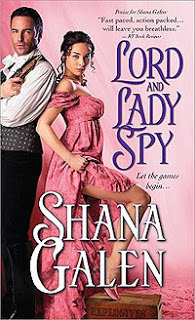 ABOUT THE BOOK:
ABOUT THE BOOK:
No man can outsmart him...
Lord Adrian Smythe may appear a perfectly boring gentleman, but he leads a thrilling life as one of England's most preeminent spies, an identity so clandestine even his wife is unaware of it. But he isn't the only one with secrets...
But one woman almost certainly can...
Now that the Napoleonic wars have come to an end, daring secret agent Lady Sophia Smythe can hardly bear the thought of returning home to her tedious husband. Until she discovers in the dark of night that he's not who she thinks he is after all...
Shana Galen's brilliant Regency world features two noble spies who cross swords and meet their match in a fast-paced, witty love story full of excitement and heart.
<A HREF="http://ws.amazon.com/widgets/q?rt=ss_... Widgets</A>
MY REVIEW:
From the opening line... "The spy called Saint hunkered down in the bottom of the wardrobe she'd occupied for the last four hours and attempted to stifle a yawn." ...I was hooked. Ms. Galen, you had me at "The spy called Saint..." There is nothing more enjoyable then opening a book and immediately being thrust into a tense scene.
I admit that when this book first graced my desk, I was intrigued. I loved the movie, Mr. and Mrs. Smith, with Angelina Jolie and Brad Pitt--a married couple with no idea that each of them are assassins until, suddenly, one day they are hired to off each other. This book reminded me of it in title, and a little bit in essence.
I enjoyed watching Lord and Lady Smythe battle it out. I loved the reveal of who they were to each other, and watching them not only grow as spies but as a couple. They'd been through a lot in the previous years before this tale begins, and much pain had been endured. Now they will learn to be a team, discover who they really are, not just that they are spies, but who they are inside. Watching them grow and change and fall in love was a treat in an of itself, besides the bad-ass action scenes! LOVE Sophia and Adrian is hot as hell. The way the two of these converse is entertaining, witty and just downright fab!
I am also distinctly reminded while reading how much Ms. Galen is intune with the Regency era. The language, the clothes, the politics, the etiquette, the every day life. We are immersed in the setting, and it doesn't detract from the story--only heightens it. I WANT to list my favorite scenes because they are just too awesome, but I don't want to give anything away... soooo I will just say these few words and when you're reading you'll know what I mean... fighting in darkness, carriages--pretty much every carriage scene, naked jumping, gardens...
Ms. Galen has a tremendous talent of writing action packed, adventure filled, sensual romances, that leave a reader wishing the book went on forever. Well done! I highly recommend LORD AND LADY SPY!
Enjoy!
 ABOUT THE BOOK:
ABOUT THE BOOK:No man can outsmart him...
Lord Adrian Smythe may appear a perfectly boring gentleman, but he leads a thrilling life as one of England's most preeminent spies, an identity so clandestine even his wife is unaware of it. But he isn't the only one with secrets...
But one woman almost certainly can...
Now that the Napoleonic wars have come to an end, daring secret agent Lady Sophia Smythe can hardly bear the thought of returning home to her tedious husband. Until she discovers in the dark of night that he's not who she thinks he is after all...
Shana Galen's brilliant Regency world features two noble spies who cross swords and meet their match in a fast-paced, witty love story full of excitement and heart.
Published on November 23, 2011 13:00
November 22, 2011
Guest Grace Burrowes, Author of The Virtuoso and Lady Sophie's Christmas Wish
 Welcome to History Undressed, today's guest author, Grace Burrowes! Writer of Regency romance, she has a lovely blog for us today. Leave a comment for a chance to win a copy of her newest release, THE VIRTUOSO. (2 winners/ US & Canada only)
Welcome to History Undressed, today's guest author, Grace Burrowes! Writer of Regency romance, she has a lovely blog for us today. Leave a comment for a chance to win a copy of her newest release, THE VIRTUOSO. (2 winners/ US & Canada only)*~*~*~*~*
Anauthor who's going to make her Regency hero a piano virtuoso had first bestdetermine whether such a thing existed at the time his story takes place.Fortunately for me and for Lord Valentine in The Virtuoso, it did—but only barely.
Mostpeople are familiar with the term "wunderkind," or wonder child, as it appliedto Mozart (1756-1791) and his sister Nannerl. Their doting if profit-mindedpapa paraded them all over Europe in the years 1762-1773, including two tripsto London (1764 and 1765). The English therefore had at least one precedent fora piano virtuoso. I was surprised to find that the first English piano virtuoso,and the first musician referred to generally as such, was none other than dearold Muzio Clementi (1752-1832).
Clementi'ssonatinas remain in our repertoire as teaching studies. They're pretty, not toolong, not too complicated, and they make nice party pieces—they also show onlythe confectionary end of Clementi's abilities. In Lord Valentine's day,Clementi, who was raised and educated in England from the age of fourteen on,would have been the grand old fellow of concert, composition, and musicpublishing fame. Clementi also built pianos and some of his technologicaladvances are still in use in our modern instruments.
Ihave a degree in music history and my instrument was piano, and yet I did notknow that Clementi was credited with influencing Chopin, Lizst and a host ofother romantic figures. I also did not know enough about the technicalevolution of the piano.
 Thefirst pianos probably date from about 1700 and were built in Italy. By Mozart'stime, they were still smallish instruments, with five octave keyboards, andonly a simple sustaining pedal. By Lord Valentine's day, small pianos forcottage use were being built along the earlier, more modest dimensions, but sotoo were concert versions and salon versions with six octaves and even afew—Beethoven had one—reaching to a seventh octave.
Thefirst pianos probably date from about 1700 and were built in Italy. By Mozart'stime, they were still smallish instruments, with five octave keyboards, andonly a simple sustaining pedal. By Lord Valentine's day, small pianos forcottage use were being built along the earlier, more modest dimensions, but sotoo were concert versions and salon versions with six octaves and even afew—Beethoven had one—reaching to a seventh octave.Therewould be something un-heroic about a big, handsome fellow in fancy eveningattire sitting down to impress the ladies by playing at an itty-bitty pianocapable of only itty-bitty sound. I was much relieved to know that grands andimposing square pianos were the norm in better households during the Regency,and that Lord Val would soon have at his disposal pianos with ranges very nearto what we play on today.
Thentoo, for a virtuoso to tour profitably, there had to be large venues for him toplay in (the English frowned on women performing for money, while the Continenttook a more liberal view). During theRegency, the primary concert venue, His Majesty's Threatre at Haymarket, wasrenovated to increase its capacity from 1200 seats to 2500.
Somuch to my relief, Lord Valentine arrived to his story at a point in musicalevolution when both worthy instruments and worthy venues were on hand toshowcase his talent… My only task was then to provide him a worthy lady toappreciate some of his other attributes—and his music too, of course.
The Virtuoso byGrace Burrowes – In Stores November 2011
A genius with aterrible loss…
Giftedpianist Valentine Windham, youngest son of the Duke of Moreland, has littleinterest in his father's obsession to see his sons married, and instead pourspassion into his music. But when Val loses his music, he flees to the country,alone and tormented by what has been robbed from him.
A widow with aheartbreaking secret…
GrievingEllen Markham has hidden herself away, looking for safety in solitude. Hercurious new neighbor offers a kindred lonely soul whose desperation is matchedonly by his desire, but Ellen's devastating secret could be the one thing thatdestroys them both.
Togetherthey'll find there's no rescue from the past, but sometimes losing everythingcan help you find what you need most.
Lady Sophie's Christmas Wish by Grace Burrowes – In Stores NOW!
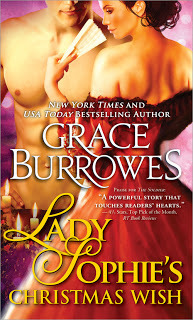
Aluminous holiday tale of romance, passion, and dreams come true from rising starGrace Burrowes, whose award-winning Regency romances are capturing heartsworldwide.
All she wants is peace and anonymity…
LadySophie Windham has maneuvered a few days to herself at the ducal mansion inLondon before she must join her family for Christmas in Kent. Suddenly trappedby a London snowstorm, she finds herself with an abandoned baby and only theassistance of a kind, handsome stranger standing between her and completedisaster.
But Sophie's holiday is about to heat up…
Withhis estate in ruins, Vim Charpentier sees little to feel festive about thisChristmas. His growing attraction for Sophie Windham is the only thing thatwarms his spirits—but when Sophie's brothers whisk her away, Vim's most painfulholiday memories are reawakened.
It seems Sophie's been keeping secrets,and now it will take much more than a mistletoe kiss to make her deepest wishescome true…
Aboutthe Author
Grace Burrowes is the pen namefor a prolific and award-winning author of historical romances. The Heir,received starred reviews from Publishers Weekly and Booklist, and was selected as a Publishers Weekly Best Bookof the Year for 2010. Both The Heir and its follow-up, The Solider,are New York Times and USA Today bestsellers. She is a practicingattorney specializing in family law and lives in a restored log cabin inwestern Maryland without a TV, DVD or radio because she's too busy working onher next books. For more information, please visit http://www.graceburrowes.com/.
Published on November 22, 2011 05:11
November 18, 2011
Political Intrigue during the Medieval Age by Terry Spear
Welcome to History Undressed, guest author Terry Spear! Terry is the award-winning author of fantasy and medieval romance. Leave a comment to win a copy of Ms. Spear's medieval romance novel, Winning the Highlander's Heart.
Political Intrigue during the Medieval AgeBy Terry Spear
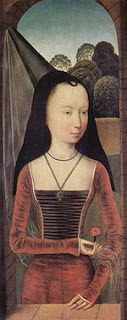 The medieval period was from about 500 AD to 1500 AD, soquite a bit of time and change.
The medieval period was from about 500 AD to 1500 AD, soquite a bit of time and change.
When we talk about one period of time, it can be verydifferent from another in terms of lifestyle, clothes, and what was availableto the populace. Also, the change in the political arena made for a lot ofdifference in medieval times.
So when we say we're writing about a medieval romance in aparticular time, it can be way different from one much later. And it dependedon the location. Some areas were still more in the Dark Ages, when others hadmoved ahead.
I chose to write about King Henry I's time period, 1100 AD,because I found him a fascinating king and the emerging scenario with histaking a wife who was the daughter of the Scottish king and the Saxon princess,who had been the niece of the Saxon king killed and replaced by Henry's father,William the Conqueror of Normandy. She was an interesting person as well, againeducated, and her mother had placed her in her aunt's convent, to ensureunscrupulous men would not have their way with her.
Now, Henry was the first of the kings who was reallyeducated as he was meant to be a bishop, not king, since he was the third sonof William. But the older brother, William Rufus, who was serving as king aftertheir father died, met his own death in a hunting accident under rathersuspicious circumstances while Henry was in attendance. The next oldest brotherwas away fighting the Crusades, so what could Henry do? But take over thetreasury and become king.
It's important to learn as much about the clothing, foodthat was served during this period of time, as well as the accommodations.Although because I write romance, I don't get into some of the smellierdetails.
But what I found the most fun while creating the story wasincluding some of the political intrigue.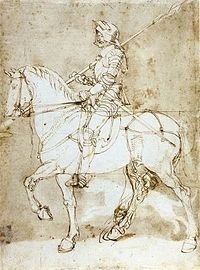
When William conquered Saxon England, the ruling king diedand the Saxon princess and prince fled to Scotland where they were givenprotection. But the Scottish king fell in love with the Saxon princess. Nowdoesn't that sound like a fairy-tale romance? It was. When he died years later,she did also, of grief.
The thing of it is, the Saxon princess's father had beenking, but his brother murdered him and took over the kingdom, and then he tookin his brother's son and daughter, since he had no children of his own. Like Isaid, lots and lots of intrigue.
The Saxon prince united with Henry's older brother, who vowsto take over England and rule as he should have. I did include some of that inthe story as well. One of the knights who they meet on the road is actually aknight that Henry used to lead his men to fight his brother.
In one case, Lady Anice and Malcolm MacNeill stay at a realcastle that was still owned by a Saxon. He had pledged his loyalty to Williamthe Conqueror, figuring probably that he would be the winner and didn't want tolose his lands.
William had offered his relation to him, after he had herhusband (a Norman baron) executed because he had plotted against William. Sothen he offers her as the wife to the Saxon lord in payment for his loyalty.She refuses and he sends her to one of the islands to live in poverty. But herdaughter doesn't want this kind of life and offers herself to marry the Saxonlord.
So that was included in the story as well. Don't you justlove all this real life intrigue?
It's so much fun to use real history that is just asfascinating as making it up!
One of the things I found also interesting was that althoughwomen wore wimples and covered their hair (because it was too enticing for mennot to be covered), but during the time that Henry's wife ruled by his side,women didn't have to wear the covering. And they often braided their hair withextensions to make it even longer!
While she was at the convent, she'd been beaten by her auntfor throwing down her hair cover and when she left there to marry Henry, shevowed not to wear it again. It became fashionable then for many of the ladiesto wear their hair uncovered.
Another thing I found fascinating was that the food wasn'tbland or dreary to eat, not in a royal household, but was decorated to a fairlywell. And fruits and vegetables were considered bad for you if it wasn't cookedfirst.
 Castles were defenses, foremost. They didn't have hugewindows, but merely arrow slots where they could shoot an approaching enemy. Ivisited several castles in Scotland and in one of the tower rooms, they had notonly the arrow slot windows, but they'd created round ones for updated weapons--guns.Men who would be holed up in the tower for a long time, watching the grounds,would use another hole nearer the base of the floor to relieve themselves.
Castles were defenses, foremost. They didn't have hugewindows, but merely arrow slots where they could shoot an approaching enemy. Ivisited several castles in Scotland and in one of the tower rooms, they had notonly the arrow slot windows, but they'd created round ones for updated weapons--guns.Men who would be holed up in the tower for a long time, watching the grounds,would use another hole nearer the base of the floor to relieve themselves.
Yep, no toilet! Where would it go? Down the wall of thetower to the ground below. :)
Also while I visited the Scottish castles, the stairs werenarrow, to prevent more than one attacker access and they always curved to theright so that the defender would have the advantage where he could swing his sword and unless theattacker was left-handed, he could not as well.
You've heard that knights were supposed to be chivalrous,right? At first, they weren't. Some would steal from those who couldn't fightback just because the knights were so well armored. Then the rule of chivalrycame into effect, and though it didn't mean everyone would abide by the rules,things got better. But one of the funny happenings I uncovered with regard toknights—was that their armored feet—the sabaton--were armored plates riveted onthe boots. For a period, the fashion was to make them longer and longer, kindof like women's pointy dress shoes. The knights would wiggle their long shinyarmor plated toes at the ladies in a sexual way, making them blush and giggle.
The church, wet blanket that it could be, declared that theshoes were indecent and could not be that long. Not sure what they said aboutthe cod pieces as the men's tunics rose ever higher and the men's cod piecesgrew ever bigger.
So that's a glimpse of medieval history undressed—a littlebit of political intrigue can go a long way!
Would you have been offended if a knight had wiggled the toeof his armored boot at you?
Terry Spear
"Giving new meaning to the term alpha male where fantasy ISreality."
www.facebook.com/terry.spearwww.terryspear.comwww.myspace.com/terryspear http://terry-spear.blogspot.com/http://twitter.com/#!/TerrySpearAuthor bio: Award-winning author Terry Spear is theauthor of urban fantasy romances and medieval Highland romances. She receivedPublishers Weekly's Best Book of the Year in 2008 for Heart of the Wolf. Aretired officer of the U.S. Army Reserves, Terry is a librarian by day. Shelives in Crawford, Texas.
CONTEST: Comment to win!
 A copy of
Winning the Highlander's Heart
will be given to one US winner, the cover of a knight, not the Highland figure.
A copy of
Winning the Highlander's Heart
will be given to one US winner, the cover of a knight, not the Highland figure.
Escaping from King Henry's advances, the Scottish Lady Anice falls into the hands of Highlander Laird Malcolm MacNeill, and murder and mayhem follow when she discovers some of her key staff are missing and she's targeted next.
*~*~*~*~*~*
 The Accidental Highland Hero
The Accidental Highland Hero
Lady Eilis Dunbarton's life undergoes a drastic change with the death of her cousin, Agnes. Now she's faced with the disagreeable prospect of marrying the man who was to be her cousin's husband. Not by a change of contract, though. Instead, by deceit—pretending to be her cousin. But if her husband-to-be discovers she's not really Agnes, her life is forfeit. So what choice does Eilis have but to flee? When Laird James MacNeill's clan rescues a half-drowned lass from the sea, there is speculation she is of the enemy clan, especially since she doesn't remember her own name. James is immediately enticed with the lady, but his focus must remain on finding the proper bride. For if he does not wed soon, he must give up his holdings to one of his younger brothers. Focus slips away with each day Eilis is close, and James finds himself contemplating the thought of taking her to wife without knowing her true identity. But how dangerous would the end result be? And what will happen if Eilis's husband-to-be comes looking for her only to find her in the arms of another man?
Political Intrigue during the Medieval AgeBy Terry Spear
 The medieval period was from about 500 AD to 1500 AD, soquite a bit of time and change.
The medieval period was from about 500 AD to 1500 AD, soquite a bit of time and change.When we talk about one period of time, it can be verydifferent from another in terms of lifestyle, clothes, and what was availableto the populace. Also, the change in the political arena made for a lot ofdifference in medieval times.
So when we say we're writing about a medieval romance in aparticular time, it can be way different from one much later. And it dependedon the location. Some areas were still more in the Dark Ages, when others hadmoved ahead.
I chose to write about King Henry I's time period, 1100 AD,because I found him a fascinating king and the emerging scenario with histaking a wife who was the daughter of the Scottish king and the Saxon princess,who had been the niece of the Saxon king killed and replaced by Henry's father,William the Conqueror of Normandy. She was an interesting person as well, againeducated, and her mother had placed her in her aunt's convent, to ensureunscrupulous men would not have their way with her.
Now, Henry was the first of the kings who was reallyeducated as he was meant to be a bishop, not king, since he was the third sonof William. But the older brother, William Rufus, who was serving as king aftertheir father died, met his own death in a hunting accident under rathersuspicious circumstances while Henry was in attendance. The next oldest brotherwas away fighting the Crusades, so what could Henry do? But take over thetreasury and become king.
It's important to learn as much about the clothing, foodthat was served during this period of time, as well as the accommodations.Although because I write romance, I don't get into some of the smellierdetails.
But what I found the most fun while creating the story wasincluding some of the political intrigue.

When William conquered Saxon England, the ruling king diedand the Saxon princess and prince fled to Scotland where they were givenprotection. But the Scottish king fell in love with the Saxon princess. Nowdoesn't that sound like a fairy-tale romance? It was. When he died years later,she did also, of grief.
The thing of it is, the Saxon princess's father had beenking, but his brother murdered him and took over the kingdom, and then he tookin his brother's son and daughter, since he had no children of his own. Like Isaid, lots and lots of intrigue.
The Saxon prince united with Henry's older brother, who vowsto take over England and rule as he should have. I did include some of that inthe story as well. One of the knights who they meet on the road is actually aknight that Henry used to lead his men to fight his brother.
In one case, Lady Anice and Malcolm MacNeill stay at a realcastle that was still owned by a Saxon. He had pledged his loyalty to Williamthe Conqueror, figuring probably that he would be the winner and didn't want tolose his lands.
William had offered his relation to him, after he had herhusband (a Norman baron) executed because he had plotted against William. Sothen he offers her as the wife to the Saxon lord in payment for his loyalty.She refuses and he sends her to one of the islands to live in poverty. But herdaughter doesn't want this kind of life and offers herself to marry the Saxonlord.
So that was included in the story as well. Don't you justlove all this real life intrigue?
It's so much fun to use real history that is just asfascinating as making it up!
One of the things I found also interesting was that althoughwomen wore wimples and covered their hair (because it was too enticing for mennot to be covered), but during the time that Henry's wife ruled by his side,women didn't have to wear the covering. And they often braided their hair withextensions to make it even longer!
While she was at the convent, she'd been beaten by her auntfor throwing down her hair cover and when she left there to marry Henry, shevowed not to wear it again. It became fashionable then for many of the ladiesto wear their hair uncovered.
Another thing I found fascinating was that the food wasn'tbland or dreary to eat, not in a royal household, but was decorated to a fairlywell. And fruits and vegetables were considered bad for you if it wasn't cookedfirst.
 Castles were defenses, foremost. They didn't have hugewindows, but merely arrow slots where they could shoot an approaching enemy. Ivisited several castles in Scotland and in one of the tower rooms, they had notonly the arrow slot windows, but they'd created round ones for updated weapons--guns.Men who would be holed up in the tower for a long time, watching the grounds,would use another hole nearer the base of the floor to relieve themselves.
Castles were defenses, foremost. They didn't have hugewindows, but merely arrow slots where they could shoot an approaching enemy. Ivisited several castles in Scotland and in one of the tower rooms, they had notonly the arrow slot windows, but they'd created round ones for updated weapons--guns.Men who would be holed up in the tower for a long time, watching the grounds,would use another hole nearer the base of the floor to relieve themselves.Yep, no toilet! Where would it go? Down the wall of thetower to the ground below. :)
Also while I visited the Scottish castles, the stairs werenarrow, to prevent more than one attacker access and they always curved to theright so that the defender would have the advantage where he could swing his sword and unless theattacker was left-handed, he could not as well.
You've heard that knights were supposed to be chivalrous,right? At first, they weren't. Some would steal from those who couldn't fightback just because the knights were so well armored. Then the rule of chivalrycame into effect, and though it didn't mean everyone would abide by the rules,things got better. But one of the funny happenings I uncovered with regard toknights—was that their armored feet—the sabaton--were armored plates riveted onthe boots. For a period, the fashion was to make them longer and longer, kindof like women's pointy dress shoes. The knights would wiggle their long shinyarmor plated toes at the ladies in a sexual way, making them blush and giggle.
The church, wet blanket that it could be, declared that theshoes were indecent and could not be that long. Not sure what they said aboutthe cod pieces as the men's tunics rose ever higher and the men's cod piecesgrew ever bigger.
So that's a glimpse of medieval history undressed—a littlebit of political intrigue can go a long way!
Would you have been offended if a knight had wiggled the toeof his armored boot at you?
Terry Spear
"Giving new meaning to the term alpha male where fantasy ISreality."
www.facebook.com/terry.spearwww.terryspear.comwww.myspace.com/terryspear http://terry-spear.blogspot.com/http://twitter.com/#!/TerrySpearAuthor bio: Award-winning author Terry Spear is theauthor of urban fantasy romances and medieval Highland romances. She receivedPublishers Weekly's Best Book of the Year in 2008 for Heart of the Wolf. Aretired officer of the U.S. Army Reserves, Terry is a librarian by day. Shelives in Crawford, Texas.
CONTEST: Comment to win!
 A copy of
Winning the Highlander's Heart
will be given to one US winner, the cover of a knight, not the Highland figure.
A copy of
Winning the Highlander's Heart
will be given to one US winner, the cover of a knight, not the Highland figure. Escaping from King Henry's advances, the Scottish Lady Anice falls into the hands of Highlander Laird Malcolm MacNeill, and murder and mayhem follow when she discovers some of her key staff are missing and she's targeted next.
*~*~*~*~*~*
 The Accidental Highland Hero
The Accidental Highland HeroLady Eilis Dunbarton's life undergoes a drastic change with the death of her cousin, Agnes. Now she's faced with the disagreeable prospect of marrying the man who was to be her cousin's husband. Not by a change of contract, though. Instead, by deceit—pretending to be her cousin. But if her husband-to-be discovers she's not really Agnes, her life is forfeit. So what choice does Eilis have but to flee? When Laird James MacNeill's clan rescues a half-drowned lass from the sea, there is speculation she is of the enemy clan, especially since she doesn't remember her own name. James is immediately enticed with the lady, but his focus must remain on finding the proper bride. For if he does not wed soon, he must give up his holdings to one of his younger brothers. Focus slips away with each day Eilis is close, and James finds himself contemplating the thought of taking her to wife without knowing her true identity. But how dangerous would the end result be? And what will happen if Eilis's husband-to-be comes looking for her only to find her in the arms of another man?
Published on November 18, 2011 03:00
November 17, 2011
Video of the Week!
This week's video is another BBC Horrible Histories song... and some of you may find it offensive, but I found it to be quite humorous.
In celebration of my alter-ego, Annabelle Weston, (which is contrived of myself and a WP), having just released a historical western romance, WICKED WOMAN, I thought it highly appropriate to play this cowboy song!
*~*~*~*~*
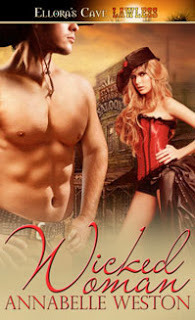 WICKED WOMAN is available now at: Amazon / Barnes and Noble / All Romance Ebooks
WICKED WOMAN is available now at: Amazon / Barnes and Noble / All Romance Ebooks
There are some things a man can't walk away from. Nathan Bender is on a quest for vengeance. What he finds is sexy saloon-dolly O'Dell Murphy. She holds the information he needs—and becomes a temptation he can't resist.
O'Dell longs for a respectable life outside the saloon. When the man Nathan is searching for steals O'Dell's savings, she has no choice but to go after him.
Torn between passion and revenge, Nathan reluctantly accompanies O'Dell through the Sonoran Desert. There are some things a man can't walk away from—and Nathan is finding it's not revenge that binds him. It's O'Dell, and the wicked, sinful pleasure she provides.
Reader Advisory: This book contains violence and a brief depiction of rape. Click here to read an excerpt.
NEWS coming soon... WICKED WOMAN is going to be the first in a series... Leave a comment to win a copy of the ebook!
In celebration of my alter-ego, Annabelle Weston, (which is contrived of myself and a WP), having just released a historical western romance, WICKED WOMAN, I thought it highly appropriate to play this cowboy song!
*~*~*~*~*
 WICKED WOMAN is available now at: Amazon / Barnes and Noble / All Romance Ebooks
WICKED WOMAN is available now at: Amazon / Barnes and Noble / All Romance EbooksThere are some things a man can't walk away from. Nathan Bender is on a quest for vengeance. What he finds is sexy saloon-dolly O'Dell Murphy. She holds the information he needs—and becomes a temptation he can't resist.
O'Dell longs for a respectable life outside the saloon. When the man Nathan is searching for steals O'Dell's savings, she has no choice but to go after him.
Torn between passion and revenge, Nathan reluctantly accompanies O'Dell through the Sonoran Desert. There are some things a man can't walk away from—and Nathan is finding it's not revenge that binds him. It's O'Dell, and the wicked, sinful pleasure she provides.
Reader Advisory: This book contains violence and a brief depiction of rape. Click here to read an excerpt.
NEWS coming soon... WICKED WOMAN is going to be the first in a series... Leave a comment to win a copy of the ebook!
Published on November 17, 2011 02:00
November 16, 2011
The Staff of Life by Ruth A. Casie
Today on History Undressed I'd like to welcome my dear friend, Ruth A. Casie! Her debut novel, Knight of Runes (which I highly recommend!) just released this week with Carina Press.
The Staff of Lifeby Ruth A. Casie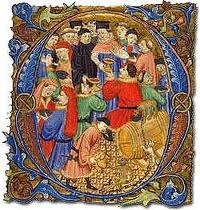
This is where it all started, the 1963 movie, Tom Jones . Albert Finney(Tom Jones) licks his chicken bones and Joyce Redman (Mrs Waters) looks likeshe's making love to an apple. It showed that playing with your food could befun and anything edible will do! But what was a banquet really like?
The extravagant feasts and banquets of the Middle Ages arelegendary. However, while menus for the wealthy were extensive, only smallportions were taken. Hosts were expected to offer extensive choices. With more extensive travel, a change insociety emerged, possibly prompted by the Crusades, that led to a new andunprecedented interest in beautiful objects and elegant manners. This changeextended to food preparation and presentation and resulted in fabulous foodarrangements with exotic colors and flavorings. Banquets prepared during theMiddle Ages were fit for a king.
Staffing and Presentingthe Banquet
The kitchen squires where responsible for provisioning thekitchen. Assisted by the cooks, they chose, purchased, and paid for the goods.
The food was plated on the serving dishes and staged in thekitchen until it was time to bring to the tables in the Great Hall.
The Noble of the castle, and his distinguished guests, satat a great table that was set on a raised platform, a dais, at one of the hall.
Buffets were tables with a series of wooden stepped shelves.The number of shelves indicated the host's rank. The more shelves the higherthe rank. The 'Stepped Buffets' were covered with rich drapes and used atbanquets and feasts. The Nobles impressed their guests by using their finestgold or silver plates as service plates on the buffet.
The banquet feast consisted of three, four, five, and evensix courses. At times the presentations of the main courses were made into atheatrical representation with colored jellies of swans or peacocks orpheasants with their feathers. Served as a specialty the beak and feet of thesebirds were gilt and placed in the middle of the table as a centerpiece.
French MedievalBanquets
The French cooking historian described a great feast givenin 1455 by the Count of Anjou, third son of King Louis II of Sicily. Thisdescription demonstrates just how theatrical the presentation was:
"On the table was placed a center-piece, which represented agreen lawn, surrounded with large peacocks' feathers and green branches, towhich were tied violets and other sweet-smelling flowers.
In the middle of this lawn a fortress was placed, coveredwith silver.
The fortress was hollow, and formed a sort of cage, in whichseveral live birds were shut up, their tufts and feet being gilt.
On its tower, which was gilt, three banners were placed.
The first course consisted of a civet of hare, a quarter ofstag which had been a night in salt, a stuffed chicken, and a loin of veal.
The two last dishes were covered with a German sauce, withgilt sugar-plums, and pomegranate seeds.
At each end, outside the green lawn, was an enormous pie,surmounted with smaller pies, which formed a crown. The crust of the large pieswere silvered all round and gilt at the top.
Each pie contained a whole roe-deer, a gosling, threecapons, six chickens, ten pigeons, one young rabbit, and, no doubt to serve asseasoning or stuffing, a minced loin of veal, two pounds of fat, and twenty-sixhard-boiled eggs, covered with saffron and flavored with cloves.
For the three following courses, there was a roe-deer, apig, a sturgeon cooked in parsley and vinegar, and covered with powderedginger.
The feast continued with a kid goat, two goslings, twelvechickens, as many pigeons, six young rabbits, two herons, a leveret, a fatcapon stuffed, four chickens covered with yolks of eggs and sprinkled withspice, a wild boar, some wafers and stars and a jelly, part white and part redrepresented the crests of the honored guests, cream covered with fennel seedsand preserved in sugar, a white cream, cheese in slices, and strawberries, and,lastly, plums stewed in rose-water
Besides these four courses, there was a fifth, entirely ofwines then in vogue, and of preserves. These consisted of fruits and varioussweet pastries."
I researched medieval banquets when I wrote Knight of Runes . Eating is fundamental and enjoyable. WhileArik and Rebeka don't get it on quite like Tom and Mrs. Waters there isdefinitely an air of playfulness in the scene. The trouble every time I read that scene is I really get hungry. I'lllet you figure out for what!
Win a free $5 Amazon gift card by leaving a comment with your email address. One person will be randomly selected at the end of the day.
Author Bio
Ruth A. Casie was born in Brooklyn, New York. Fortwenty-five years she's been writing for corporate America. Encouraged by herfamily and friends this ballroom dancing, Sudoku playing, aspiring gourmet cookhas given way to her inner muse and let her creative juices flow. Discoverstrong men and empowered women as they face unexpected challenges. Watch theirstories unfold as they encounter magic, danger, and passion. Join them as theyrace across the pages to places where love and time know no bounds. ABOUT THE BOOK:England, 1605
ABOUT THE BOOK:England, 1605
When Lord Arik, a druid knight, finds Rebeka Tyler wandering his lands without protection, he swears to keep her safe. But Rebeka can take care of herself. When Arik sees her clash with a group of attackers using a strange fighting style, he's intrigued.
Rebeka is no ordinary seventeenth-century woman—she's travelled back from the year 2011, and she desperately wants to return to her own time. She poses as a scholar sent by the king to find out what's killing Arik's land. But as she works to decode the ancient runes that are the key to solving this mystery and sending her home, she finds herself drawn to the charismatic and powerful Arik.
As Arik and Rebeka fall in love, someone in Arik's household schemes to keep them apart, and a dark druid with a grudge prepares his revenge. Soon Rebeka will have to decide whether to return to the future or trust Arik with the secret of her time travel and her heart.
Title: Knightof RunesISBN:978-14268-9258-5Publisher: CarinaPress Release Date:November 14, 2011Genre:Historical Fantasy time-travelRuth's website: www.ruthacasie.com Ruth's blog: ruthacasie.blogspot.com Ruth'sTwitter: Twitter.com/RuthACasie
The Staff of Lifeby Ruth A. Casie

This is where it all started, the 1963 movie, Tom Jones . Albert Finney(Tom Jones) licks his chicken bones and Joyce Redman (Mrs Waters) looks likeshe's making love to an apple. It showed that playing with your food could befun and anything edible will do! But what was a banquet really like?
The extravagant feasts and banquets of the Middle Ages arelegendary. However, while menus for the wealthy were extensive, only smallportions were taken. Hosts were expected to offer extensive choices. With more extensive travel, a change insociety emerged, possibly prompted by the Crusades, that led to a new andunprecedented interest in beautiful objects and elegant manners. This changeextended to food preparation and presentation and resulted in fabulous foodarrangements with exotic colors and flavorings. Banquets prepared during theMiddle Ages were fit for a king.
Staffing and Presentingthe Banquet
The kitchen squires where responsible for provisioning thekitchen. Assisted by the cooks, they chose, purchased, and paid for the goods.
The food was plated on the serving dishes and staged in thekitchen until it was time to bring to the tables in the Great Hall.
The Noble of the castle, and his distinguished guests, satat a great table that was set on a raised platform, a dais, at one of the hall.
Buffets were tables with a series of wooden stepped shelves.The number of shelves indicated the host's rank. The more shelves the higherthe rank. The 'Stepped Buffets' were covered with rich drapes and used atbanquets and feasts. The Nobles impressed their guests by using their finestgold or silver plates as service plates on the buffet.
The banquet feast consisted of three, four, five, and evensix courses. At times the presentations of the main courses were made into atheatrical representation with colored jellies of swans or peacocks orpheasants with their feathers. Served as a specialty the beak and feet of thesebirds were gilt and placed in the middle of the table as a centerpiece.
French MedievalBanquets
The French cooking historian described a great feast givenin 1455 by the Count of Anjou, third son of King Louis II of Sicily. Thisdescription demonstrates just how theatrical the presentation was:
"On the table was placed a center-piece, which represented agreen lawn, surrounded with large peacocks' feathers and green branches, towhich were tied violets and other sweet-smelling flowers.
In the middle of this lawn a fortress was placed, coveredwith silver.
The fortress was hollow, and formed a sort of cage, in whichseveral live birds were shut up, their tufts and feet being gilt.
On its tower, which was gilt, three banners were placed.
The first course consisted of a civet of hare, a quarter ofstag which had been a night in salt, a stuffed chicken, and a loin of veal.
The two last dishes were covered with a German sauce, withgilt sugar-plums, and pomegranate seeds.
At each end, outside the green lawn, was an enormous pie,surmounted with smaller pies, which formed a crown. The crust of the large pieswere silvered all round and gilt at the top.
Each pie contained a whole roe-deer, a gosling, threecapons, six chickens, ten pigeons, one young rabbit, and, no doubt to serve asseasoning or stuffing, a minced loin of veal, two pounds of fat, and twenty-sixhard-boiled eggs, covered with saffron and flavored with cloves.
For the three following courses, there was a roe-deer, apig, a sturgeon cooked in parsley and vinegar, and covered with powderedginger.
The feast continued with a kid goat, two goslings, twelvechickens, as many pigeons, six young rabbits, two herons, a leveret, a fatcapon stuffed, four chickens covered with yolks of eggs and sprinkled withspice, a wild boar, some wafers and stars and a jelly, part white and part redrepresented the crests of the honored guests, cream covered with fennel seedsand preserved in sugar, a white cream, cheese in slices, and strawberries, and,lastly, plums stewed in rose-water
Besides these four courses, there was a fifth, entirely ofwines then in vogue, and of preserves. These consisted of fruits and varioussweet pastries."
I researched medieval banquets when I wrote Knight of Runes . Eating is fundamental and enjoyable. WhileArik and Rebeka don't get it on quite like Tom and Mrs. Waters there isdefinitely an air of playfulness in the scene. The trouble every time I read that scene is I really get hungry. I'lllet you figure out for what!
Win a free $5 Amazon gift card by leaving a comment with your email address. One person will be randomly selected at the end of the day.
Author Bio
Ruth A. Casie was born in Brooklyn, New York. Fortwenty-five years she's been writing for corporate America. Encouraged by herfamily and friends this ballroom dancing, Sudoku playing, aspiring gourmet cookhas given way to her inner muse and let her creative juices flow. Discoverstrong men and empowered women as they face unexpected challenges. Watch theirstories unfold as they encounter magic, danger, and passion. Join them as theyrace across the pages to places where love and time know no bounds.
 ABOUT THE BOOK:England, 1605
ABOUT THE BOOK:England, 1605When Lord Arik, a druid knight, finds Rebeka Tyler wandering his lands without protection, he swears to keep her safe. But Rebeka can take care of herself. When Arik sees her clash with a group of attackers using a strange fighting style, he's intrigued.
Rebeka is no ordinary seventeenth-century woman—she's travelled back from the year 2011, and she desperately wants to return to her own time. She poses as a scholar sent by the king to find out what's killing Arik's land. But as she works to decode the ancient runes that are the key to solving this mystery and sending her home, she finds herself drawn to the charismatic and powerful Arik.
As Arik and Rebeka fall in love, someone in Arik's household schemes to keep them apart, and a dark druid with a grudge prepares his revenge. Soon Rebeka will have to decide whether to return to the future or trust Arik with the secret of her time travel and her heart.
Title: Knightof RunesISBN:978-14268-9258-5Publisher: CarinaPress Release Date:November 14, 2011Genre:Historical Fantasy time-travelRuth's website: www.ruthacasie.com Ruth's blog: ruthacasie.blogspot.com Ruth'sTwitter: Twitter.com/RuthACasie
Published on November 16, 2011 03:00
November 15, 2011
What NOT to Wear in the 14th Century by Amanda Forester
Welcome back to History Undressed, guest author, Amanda Forester. Ms. Forester last visited us in March of 2010 with her post, Color Me Medieval. I'm glad to have her back today, and with another exciting Scottish historical romance out!
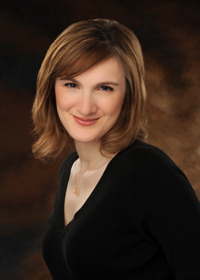 What Not to Wear in the 14th Centuryby Amanda Forester
What Not to Wear in the 14th Centuryby Amanda Forester
One of the most interesting, or at least the most time consuming,aspects of writing historical fiction is conducting all the research. Clothing is one of the biggest questions Ineed to figure out before my characters can step forth on their journey. In my newest release, The Highlander's Heart,the heroine is an English countess. Thedate is 1355. The question: what wouldshe wear?
In the first scene Isabelle (Countess of Tynsdale) is separated, or Ishould say separates herself, from her traveling companions (and the guards whoare taking her back to be killed). As Iwrote the scene I had to try to picture what she might be wearing. We're in medieval England, so obviously shewill be wearing some sort of gown, but what fabric?
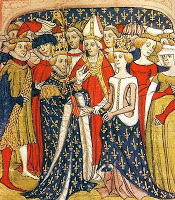 Sumptuary laws can be a help. Inthe 14th century, the rise of a prosperous merchant class became a bother forthe nobility. The upstart commoners weregaining as much wealth as the established aristocracy and could start dressingthe part (oh, the horror). Can youimagine the daughter of a merchant wearing a similar gown as the daughter of anearl? Certainly not! Sumptuary laws strictly governed what peopleof different classes could wear so the privilege and rank of the aristocracycould be maintained, and the prosperous bourgeoisie could be kept in theirplace. In particular, women were not towear clothing above the rank of their fathers or husbands. Certain fabrics, such as velvet, silk,ermine, or sable fur were prohibited to "commoners". Since my heroine is a countess, it would belikely her clothing would reflect her rank, thus I dressed her in a rich wine-coloredvelvet.
Sumptuary laws can be a help. Inthe 14th century, the rise of a prosperous merchant class became a bother forthe nobility. The upstart commoners weregaining as much wealth as the established aristocracy and could start dressingthe part (oh, the horror). Can youimagine the daughter of a merchant wearing a similar gown as the daughter of anearl? Certainly not! Sumptuary laws strictly governed what peopleof different classes could wear so the privilege and rank of the aristocracycould be maintained, and the prosperous bourgeoisie could be kept in theirplace. In particular, women were not towear clothing above the rank of their fathers or husbands. Certain fabrics, such as velvet, silk,ermine, or sable fur were prohibited to "commoners". Since my heroine is a countess, it would belikely her clothing would reflect her rank, thus I dressed her in a rich wine-coloredvelvet.
But wait, I am getting ahead of myself. What about underclothes? Underher gown, a medieval lady would have worn a linen or silk chemise, which was aloose fitting smock-like dress. Shewould have worn hose, though usually only to the knee, and leather shoes, whichin the 14th century would have had a pointed toe. These shoes were generally for castle use; ifgoing outdoors, one would put on wooden patens to avoid getting wet feet.
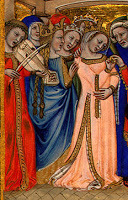 Over the chemise, a lady would wear her gown called a kirtle. In the 14th century, the previous fashion ofstraight seams and draped garments were giving way to curved seams and morecareful tailoring. Since Lady Isabelleis noble, I expect her clothes would have had the benefit of time and money, solikley her gown would have fit her quite well. Since she would have had ladies to dress her, she would probably havebeen laced into her gown in a way not possible if you were dressingyourself. Her sleeves would have beenform fitting and long, perhaps to her knuckles. These long sleeves would have been laced or buttoned in place. The neckline of this era was becoming widerand lower, and may even have revealed a little cleavage.
Over the chemise, a lady would wear her gown called a kirtle. In the 14th century, the previous fashion ofstraight seams and draped garments were giving way to curved seams and morecareful tailoring. Since Lady Isabelleis noble, I expect her clothes would have had the benefit of time and money, solikley her gown would have fit her quite well. Since she would have had ladies to dress her, she would probably havebeen laced into her gown in a way not possible if you were dressingyourself. Her sleeves would have beenform fitting and long, perhaps to her knuckles. These long sleeves would have been laced or buttoned in place. The neckline of this era was becoming widerand lower, and may even have revealed a little cleavage.
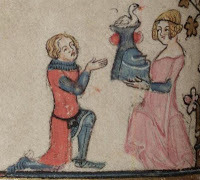 Over the kirtle, a medieval lady may have worn a variety of differentkinds of overgowns. Some may have hadloose fitting sleeves, while others were sleeveless (called surcoats), whichmay have been worn loose or laced. Later in the 14th century, surcoats becameshorter, ending at the waistline, and were often form fitting to reveal a smallwaist. A belt was commonly worn, hanginglow on the hips. These belts, orgirdles, could be quite ornate. Sumptuarylaws forbade commoners from wearing a silver girdle, so clearly the nobilitywere using their belts to show their rank. These belt could be quite fine and even encrusted with jewels.
Over the kirtle, a medieval lady may have worn a variety of differentkinds of overgowns. Some may have hadloose fitting sleeves, while others were sleeveless (called surcoats), whichmay have been worn loose or laced. Later in the 14th century, surcoats becameshorter, ending at the waistline, and were often form fitting to reveal a smallwaist. A belt was commonly worn, hanginglow on the hips. These belts, orgirdles, could be quite ornate. Sumptuarylaws forbade commoners from wearing a silver girdle, so clearly the nobilitywere using their belts to show their rank. These belt could be quite fine and even encrusted with jewels.
On her head a lady would wear some sort of covering. Being married, Isabelle's veil would be moremodest, possibly including a gorget, which wrapped around the chin and coveredthe neck. Being a lady, she would mostlikely wear a veil made of silk. Unfortunately for Isabelle, she loses her veil during her escape, and sowhen she meets the hero, Laird David Campbell, he assumes she is not of highsocial standing or moral character. Notrue lady would be traveling alone with her hair flowing loose. Thus begins the story of David and Isabelle!
I have always loved the long flowing gowns and rich colorsand fabrics of medieval times. Whatwould you have enjoyed wearing if you were living in the 14th century? Comment on the blog for a chance to win acopy of THE HIGHLANDER'S HEART.
 THE HIGHLANDER'SHEART
THE HIGHLANDER'SHEART
Lady Isabelle escapes her murderous English husband only tobe abducted by a Highland warrior and held for ransom. Her determinationto break free from captivity is exceeded only by the passion growing betweenher and the Highland Laird. David Campbell plans to hold Isabelle forransom as an easy way to line his pockets and return her back where shebelongs, but he is unprepared for a feisty English lass with a penchant forfinding trouble. Caught between rival clans bent on claiming the throneof Scotland, Campbell must choose a side, and a bride. Standing on thebrink of war, Isabelle may be his only hope to save his clan, and his heart
Visit Amanda: website, facebook, or twitter.
 What Not to Wear in the 14th Centuryby Amanda Forester
What Not to Wear in the 14th Centuryby Amanda ForesterOne of the most interesting, or at least the most time consuming,aspects of writing historical fiction is conducting all the research. Clothing is one of the biggest questions Ineed to figure out before my characters can step forth on their journey. In my newest release, The Highlander's Heart,the heroine is an English countess. Thedate is 1355. The question: what wouldshe wear?
In the first scene Isabelle (Countess of Tynsdale) is separated, or Ishould say separates herself, from her traveling companions (and the guards whoare taking her back to be killed). As Iwrote the scene I had to try to picture what she might be wearing. We're in medieval England, so obviously shewill be wearing some sort of gown, but what fabric?
 Sumptuary laws can be a help. Inthe 14th century, the rise of a prosperous merchant class became a bother forthe nobility. The upstart commoners weregaining as much wealth as the established aristocracy and could start dressingthe part (oh, the horror). Can youimagine the daughter of a merchant wearing a similar gown as the daughter of anearl? Certainly not! Sumptuary laws strictly governed what peopleof different classes could wear so the privilege and rank of the aristocracycould be maintained, and the prosperous bourgeoisie could be kept in theirplace. In particular, women were not towear clothing above the rank of their fathers or husbands. Certain fabrics, such as velvet, silk,ermine, or sable fur were prohibited to "commoners". Since my heroine is a countess, it would belikely her clothing would reflect her rank, thus I dressed her in a rich wine-coloredvelvet.
Sumptuary laws can be a help. Inthe 14th century, the rise of a prosperous merchant class became a bother forthe nobility. The upstart commoners weregaining as much wealth as the established aristocracy and could start dressingthe part (oh, the horror). Can youimagine the daughter of a merchant wearing a similar gown as the daughter of anearl? Certainly not! Sumptuary laws strictly governed what peopleof different classes could wear so the privilege and rank of the aristocracycould be maintained, and the prosperous bourgeoisie could be kept in theirplace. In particular, women were not towear clothing above the rank of their fathers or husbands. Certain fabrics, such as velvet, silk,ermine, or sable fur were prohibited to "commoners". Since my heroine is a countess, it would belikely her clothing would reflect her rank, thus I dressed her in a rich wine-coloredvelvet. But wait, I am getting ahead of myself. What about underclothes? Underher gown, a medieval lady would have worn a linen or silk chemise, which was aloose fitting smock-like dress. Shewould have worn hose, though usually only to the knee, and leather shoes, whichin the 14th century would have had a pointed toe. These shoes were generally for castle use; ifgoing outdoors, one would put on wooden patens to avoid getting wet feet.
 Over the chemise, a lady would wear her gown called a kirtle. In the 14th century, the previous fashion ofstraight seams and draped garments were giving way to curved seams and morecareful tailoring. Since Lady Isabelleis noble, I expect her clothes would have had the benefit of time and money, solikley her gown would have fit her quite well. Since she would have had ladies to dress her, she would probably havebeen laced into her gown in a way not possible if you were dressingyourself. Her sleeves would have beenform fitting and long, perhaps to her knuckles. These long sleeves would have been laced or buttoned in place. The neckline of this era was becoming widerand lower, and may even have revealed a little cleavage.
Over the chemise, a lady would wear her gown called a kirtle. In the 14th century, the previous fashion ofstraight seams and draped garments were giving way to curved seams and morecareful tailoring. Since Lady Isabelleis noble, I expect her clothes would have had the benefit of time and money, solikley her gown would have fit her quite well. Since she would have had ladies to dress her, she would probably havebeen laced into her gown in a way not possible if you were dressingyourself. Her sleeves would have beenform fitting and long, perhaps to her knuckles. These long sleeves would have been laced or buttoned in place. The neckline of this era was becoming widerand lower, and may even have revealed a little cleavage.  Over the kirtle, a medieval lady may have worn a variety of differentkinds of overgowns. Some may have hadloose fitting sleeves, while others were sleeveless (called surcoats), whichmay have been worn loose or laced. Later in the 14th century, surcoats becameshorter, ending at the waistline, and were often form fitting to reveal a smallwaist. A belt was commonly worn, hanginglow on the hips. These belts, orgirdles, could be quite ornate. Sumptuarylaws forbade commoners from wearing a silver girdle, so clearly the nobilitywere using their belts to show their rank. These belt could be quite fine and even encrusted with jewels.
Over the kirtle, a medieval lady may have worn a variety of differentkinds of overgowns. Some may have hadloose fitting sleeves, while others were sleeveless (called surcoats), whichmay have been worn loose or laced. Later in the 14th century, surcoats becameshorter, ending at the waistline, and were often form fitting to reveal a smallwaist. A belt was commonly worn, hanginglow on the hips. These belts, orgirdles, could be quite ornate. Sumptuarylaws forbade commoners from wearing a silver girdle, so clearly the nobilitywere using their belts to show their rank. These belt could be quite fine and even encrusted with jewels.On her head a lady would wear some sort of covering. Being married, Isabelle's veil would be moremodest, possibly including a gorget, which wrapped around the chin and coveredthe neck. Being a lady, she would mostlikely wear a veil made of silk. Unfortunately for Isabelle, she loses her veil during her escape, and sowhen she meets the hero, Laird David Campbell, he assumes she is not of highsocial standing or moral character. Notrue lady would be traveling alone with her hair flowing loose. Thus begins the story of David and Isabelle!
I have always loved the long flowing gowns and rich colorsand fabrics of medieval times. Whatwould you have enjoyed wearing if you were living in the 14th century? Comment on the blog for a chance to win acopy of THE HIGHLANDER'S HEART.
 THE HIGHLANDER'SHEART
THE HIGHLANDER'SHEARTLady Isabelle escapes her murderous English husband only tobe abducted by a Highland warrior and held for ransom. Her determinationto break free from captivity is exceeded only by the passion growing betweenher and the Highland Laird. David Campbell plans to hold Isabelle forransom as an easy way to line his pockets and return her back where shebelongs, but he is unprepared for a feisty English lass with a penchant forfinding trouble. Caught between rival clans bent on claiming the throneof Scotland, Campbell must choose a side, and a bride. Standing on thebrink of war, Isabelle may be his only hope to save his clan, and his heart
Visit Amanda: website, facebook, or twitter.
Published on November 15, 2011 02:00
November 14, 2011
New Book -- Time Travel Poll
Hello all! I'm working on a new Highlander time-travel romance novel--in the plotting stages. But before I could continue, I wanted to know what readers want as far as the time-traveling element, in a story. My hero is a hot Highland warrior from the past, and the heroine is from present day.
When you're reading time-travel, do you prefer the hero to travel from the past to the future, the heroine to travel to the past, or a mix of both?
If you'd be so kind as to fill out the poll on the right side of this blog, I would be grateful!
Cheers,
Eliza
When you're reading time-travel, do you prefer the hero to travel from the past to the future, the heroine to travel to the past, or a mix of both?
If you'd be so kind as to fill out the poll on the right side of this blog, I would be grateful!
Cheers,
Eliza
Published on November 14, 2011 11:19
November 11, 2011
Happy Veteran's Day
The Readers and Writers of History Undressed would like to extend our deepest gratitude to those who serve. We would not be where we are today without you!
Happy Veteran's Day!
Happy Veteran's Day!
Published on November 11, 2011 07:52



